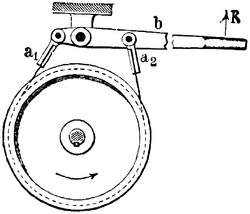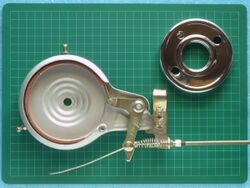Engineering:Band brake
A band brake is a primary or secondary brake, consisting of a band of friction material that tightens concentrically around a cylindrical piece of equipment or train wheel to either prevent it from rotating (a static or "holding" brake), or to slow it (a dynamic brake). This application is common on winch drums and chain saws and is also used for some bicycle brakes.[1]
A former application was the locking of gear rings in epicyclic gearing. In modern automatic transmissions this task has been taken over entirely by multiple-plate clutches or multiple-plate brakes.[citation needed]
Features
Band brakes can be simple, compact, rugged, and can generate high force with a light input force. However, band brakes are prone to grabbing or chatter and loss of brake force when hot. These problems are inherent with the design and thus limit where band brakes are a good solution.
Effectiveness
One way to describe the effectiveness of the brake is as [math]\displaystyle{ e^{\mu \theta} }[/math], where [math]\displaystyle{ \mu }[/math] is the coefficient of friction between band and drum, and [math]\displaystyle{ \theta }[/math] is the angle of wrap. With a large [math]\displaystyle{ \mu \theta }[/math], the brake is very effective and requires low input force to achieve high brake force, but is also very sensitive to changes in [math]\displaystyle{ \mu }[/math]. For example, light rust on the drum may cause the brake to "grab" or chatter, water may cause the brake to slip, and rising temperatures in braking may cause the coefficient of friction to drop slightly but in turn cause brake force to drop greatly. Using a band material with low [math]\displaystyle{ \mu }[/math] increases the input force required to achieve a given brake force, but some low-[math]\displaystyle{ \mu }[/math] materials also have more consistent [math]\displaystyle{ \mu }[/math] across the range of working temperatures.
See also
- Bicycle band brake
- Prony brake, a form of band brake used for the measurement of torque and horsepower.
References
- ↑ Atkins, Tony; Escudier, Marcel, eds (2013). "Band Brake". A Dictionary of Mechanical Engineering. Oxford University Press. ISBN 9780191752308. https://www.oxfordreference.com/display/10.1093/acref/9780199587438.001.0001/acref-9780199587438-e-428?rskey=dZB4VP&result=1. Retrieved 1 February 2024.
 |




